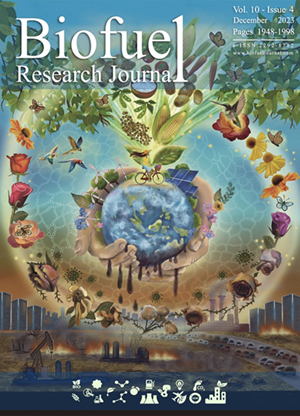生物预处理高粱壳酶解制备生物乙醇
IF 11.9
Q1 ENERGY & FUELS
引用次数: 31
摘要
木质纤维素生物质的生物预处理被认为是节能和经济的。本研究用白腐真菌黄孢原毛平革菌(MTCC 4955)在浸没静态条件下对高粱壳进行生物预处理。木质素过氧化物酶(0.843U/mL)和锰过氧化物酶(0.389U/mL)等木质素水解酶在高粱壳的生物预处理中起着重要作用。对黄孢菌对高粱壳进行生物预处理时,内葡聚糖酶(57.25U/mL)、外葡聚糖酶(4.76U/mL),滤纸酶(0.580U/mL)和葡糖淀粉酶(153.38U/mL)以及木聚糖酶(88.14U/mL)等不同水解酶的活性进行了评价。未处理高粱壳和生物预处理高粱壳的酶水解分别产生20.07和103.0mg/g的还原糖。这一结果表明,与未处理的高粱壳相比,生物预处理的高粱皮中的还原糖产量显著增加。使用酿酒酵母(KCTC 7296)、嗜单宁Pachysolen(MTCC 1077)和它们的共培养物进一步发酵生物预处理的高粱壳水解物48小时,乙醇产量分别为2.113、1.095和2.348%。使用FTIR、XRD和SEM对脱木素和水解后的基质表面特性进行了评估,证实了生物预处理工艺的有效性。本文章由计算机程序翻译,如有差异,请以英文原文为准。
Enzymatic hydrolysis of biologically pretreated sorghum husk for bioethanol production
Biological pretreatment of lignocellulosic biomass is considered to be energy-efficient and cost-effective. In the present study, sorghum husk was biologically pretreated with a white-rot fungus Phanerochaete chrysosporium (MTCC 4955) under submerged static condition. Ligninolytic enzymes like lignin peroxidase (0.843 U/mL) and manganese peroxidase (0.389 U/mL) played an important role in the biological pretreatment of sorghum husk. Activities of different hydrolytic enzymes such as endoglucanase (57.25 U/mL), exoglucanase (4.76 U/mL), filter paperase (0.580 U/mL), glucoamylase (153.38 U/mL), and xylanase (88.14 U/mL) during biological pretreatment of sorghum husk by P. chrysosporium were evaluated. Enzymatic hydrolysis of untreated sorghum husk and biologically pretreated sorghum husk produced 20.07 and 103.0 mg/g reducing sugars, respectively. This result showed a significant increase in reducing sugar production in the biologically pretreated sorghum husk as compared to its untreated counterpart. Biologically pretreated sorghum husk hydrolysate was further fermented for 48 h using Saccharomyces cerevisiae (KCTC 7296), Pachysolen tannophilus (MTCC 1077), and their co-culture resulting in ethanol yields of 2.113, 1.095, and 2.348%, respectively. The surface characteristics of the substrate were evaluated after the delignification and hydrolysis, using FTIR, XRD, and SEM, confirming the effectiveness of the biological pretreatment process.
求助全文
通过发布文献求助,成功后即可免费获取论文全文。
去求助
来源期刊

Biofuel Research Journal-BRJ
ENERGY & FUELS-
CiteScore
22.10
自引率
1.50%
发文量
15
审稿时长
8 weeks
期刊介绍:
Biofuel Research Journal (BRJ) is a leading, peer-reviewed academic journal that focuses on high-quality research in the field of biofuels, bioproducts, and biomass-derived materials and technologies. The journal's primary goal is to contribute to the advancement of knowledge and understanding in the areas of sustainable energy solutions, environmental protection, and the circular economy. BRJ accepts various types of articles, including original research papers, review papers, case studies, short communications, and hypotheses. The specific areas covered by the journal include Biofuels and Bioproducts, Biomass Valorization, Biomass-Derived Materials for Energy and Storage Systems, Techno-Economic and Environmental Assessments, Climate Change and Sustainability, and Biofuels and Bioproducts in Circular Economy, among others. BRJ actively encourages interdisciplinary collaborations among researchers, engineers, scientists, policymakers, and industry experts to facilitate the adoption of sustainable energy solutions and promote a greener future. The journal maintains rigorous standards of peer review and editorial integrity to ensure that only impactful and high-quality research is published. Currently, BRJ is indexed by several prominent databases such as Web of Science, CAS Databases, Directory of Open Access Journals, Scimago Journal Rank, Scopus, Google Scholar, Elektronische Zeitschriftenbibliothek EZB, et al.
 求助内容:
求助内容: 应助结果提醒方式:
应助结果提醒方式:


